


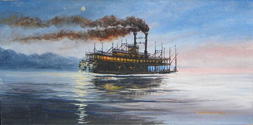
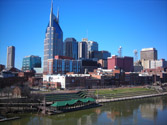
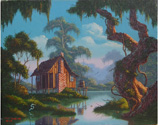
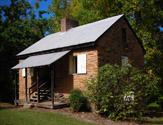









Cotton States Archive
Healey Building Post Card Begs the Question: Who Was Marie Brandon?
Though dwarfed by surrounding skyscrapers, Atlanta's Healey Building has been one of the city's prominent downtown fixtures for nearly a hundred years. Located at 57 Forsyth Street, just blocks from the famous Winecoff Hotel (which reopened in 2007 as the boutique-style Ellis Hotel), the 16-floor Healey Building was named after its developer, William T. Healey.
Built in 1913, the Healey Building was designed by Walter T. Downing in collaboration with the firm of Bruce and Morgan. Downing was particularly noted for his stylish residential architectural designs for affluent Atlantans in the late 19th Century. However, his work included a number of other Atlanta properties such as the Sacred Heart Catholic Church, a Peachtree Street landmark now conspicuous among downtown's office towers and hotels because of its diminished size, Romaneque revival design and twin spires. Additionally, Downing was responsible for the grand Hotel Patten in Chattanooga.
Built in 1913, the Healey Building was designed by Walter T. Downing in collaboration with the firm of Bruce and Morgan. Downing was particularly noted for his stylish residential architectural designs for affluent Atlantans in the late 19th Century. However, his work included a number of other Atlanta properties such as the Sacred Heart Catholic Church, a Peachtree Street landmark now conspicuous among downtown's office towers and hotels because of its diminished size, Romaneque revival design and twin spires. Additionally, Downing was responsible for the grand Hotel Patten in Chattanooga.
The Healey Building was designated a landmark by both the National Register of Historic Places and the City of Atlanta in 1976 and 1991 respectively. In 2001, the structure was converted to condominiums.
About This Post Card
Postally unused, the age of this card is difficult to ascertain, but it is quite old if the automobiles depicted in the image or its handwritten message on the reverse provide any indication.
This post card is unique for a couple of reasons. First of all, "Healey" was misspelled. Secondly, the handwritten note reveals the card was part of some correspondence. This post card is numbered "3," obviously indicating that two other cards or pieces of paper contained the first parts of the message. With the last sentence being incomplete, clearly the body of the letter continued onto another page or card. The identity of the writer is unclear and to whom the message was directed is unknown.
Historically important, the message mentions two Atlanta entities: Childs Restaurant and Keith's Vaudeville House. Before the advent of motion pictures, vaudeville was a popular entertainment form. Featuring music, dance and comedy, usually in short, independent acts, vaudeville shows were presented by a large number of large circuits (or chain theaters). Benjamin Keith had opened the first American vaudeville house in 1883 in Boston, Massachusetts, and the Atlanta theater referenced in this card's handwritten message was part of his chain of theaters.
Pioneering female blues singers like Bessie Smith and Ida Cox began their performance careers in vaudeville shows. This card refers to Marie Brandon, but an extensive search unearthed nothing about her. It is unclear whether she was a singer, dancer, comedian or adult entertainer. Since she was "working Keith's vaudville house" with "Smith & Cook . . . 2 burlesque men . . . ," it is very possible that her performances were sexually overt or outright vulgar. Burlesque performances were quite common at the time, and some vaudeville shows catered to an all-male clientele in the same manner as do modern strip bars and so-called gentlemen's clubs.
About This Post Card
Postally unused, the age of this card is difficult to ascertain, but it is quite old if the automobiles depicted in the image or its handwritten message on the reverse provide any indication.
This post card is unique for a couple of reasons. First of all, "Healey" was misspelled. Secondly, the handwritten note reveals the card was part of some correspondence. This post card is numbered "3," obviously indicating that two other cards or pieces of paper contained the first parts of the message. With the last sentence being incomplete, clearly the body of the letter continued onto another page or card. The identity of the writer is unclear and to whom the message was directed is unknown.
Historically important, the message mentions two Atlanta entities: Childs Restaurant and Keith's Vaudeville House. Before the advent of motion pictures, vaudeville was a popular entertainment form. Featuring music, dance and comedy, usually in short, independent acts, vaudeville shows were presented by a large number of large circuits (or chain theaters). Benjamin Keith had opened the first American vaudeville house in 1883 in Boston, Massachusetts, and the Atlanta theater referenced in this card's handwritten message was part of his chain of theaters.
Pioneering female blues singers like Bessie Smith and Ida Cox began their performance careers in vaudeville shows. This card refers to Marie Brandon, but an extensive search unearthed nothing about her. It is unclear whether she was a singer, dancer, comedian or adult entertainer. Since she was "working Keith's vaudville house" with "Smith & Cook . . . 2 burlesque men . . . ," it is very possible that her performances were sexually overt or outright vulgar. Burlesque performances were quite common at the time, and some vaudeville shows catered to an all-male clientele in the same manner as do modern strip bars and so-called gentlemen's clubs.
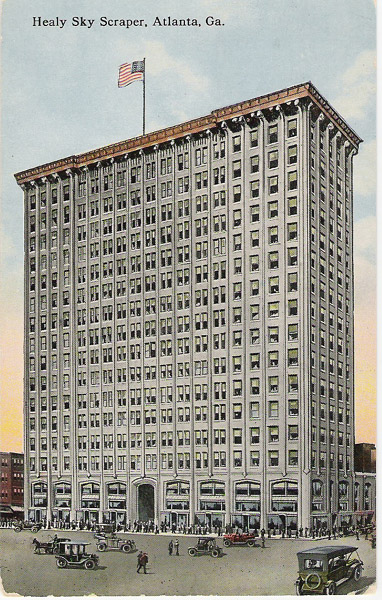
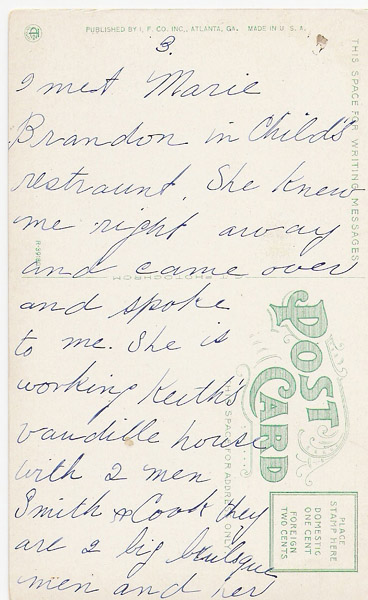
" I met Marie Brandon in Child's restraunt. She knew me right away and came over and spoke to me. She is working Keith's vaudville house with 2 men Smith & Cook they are 2 big burlesque [?] men and her . . . "
BIBLIOGRAPHY
Steve Goodson, Highbrows, Hillbillies & Hellfire: Public Entertainment in Atlanta, 1880-1930 (Athens and London: University of Georgia Press, 2002).
"Healey Building," City of Atlanta Online, Retrieved August 2007: http://www.atlantaga.gov
"Healey Building Condominiums," Emporis, Retrieved August 2007: http://www.emporis.com
"W. T. Downing (1865-1918)," New Georgia Encyclopedia, Retrieved August 2007: http://www.newgeorgiaencyclopedia.org
Steve Goodson, Highbrows, Hillbillies & Hellfire: Public Entertainment in Atlanta, 1880-1930 (Athens and London: University of Georgia Press, 2002).
"Healey Building," City of Atlanta Online, Retrieved August 2007: http://www.atlantaga.gov
"Healey Building Condominiums," Emporis, Retrieved August 2007: http://www.emporis.com
"W. T. Downing (1865-1918)," New Georgia Encyclopedia, Retrieved August 2007: http://www.newgeorgiaencyclopedia.org
Author: Greg Freeman. Published August 18, 2007.
Copyright
Southern Edition
All Rights Reserved
Southern Edition
All Rights Reserved
All materials contained on this site, including text and images, are protected by copyright laws and may not be reproduced without prior written permission from the publisher. Where applicable, use of some items contained on this site may require permission from other copyright owners.
Fair Use of text from SouthernEdition.com is permitted to the extent allowed by copyright. Proper citation is requested. Please use this guide when citing a Southern Edition article.
Contact Greg Freeman or SouthernEdition.comFair Use of text from SouthernEdition.com is permitted to the extent allowed by copyright. Proper citation is requested. Please use this guide when citing a Southern Edition article.